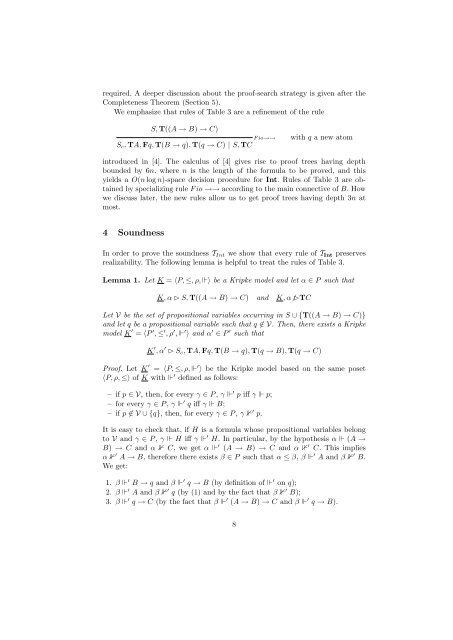A refined calculus for Intuitionistic Propositional Logic - DISCo
A refined calculus for Intuitionistic Propositional Logic - DISCo
A refined calculus for Intuitionistic Propositional Logic - DISCo
You also want an ePaper? Increase the reach of your titles
YUMPU automatically turns print PDFs into web optimized ePapers that Google loves.
equired. A deeper discussion about the proof-search strategy is given after theCompleteness Theorem (Section 5).We emphasize that rules of Table 3 are a refinement of the ruleS, T((A → B) → C)F io→→S c , TA, Fq, T(B → q), T(q → C) | S, TCwith q a new atomintroduced in [4]. The <strong>calculus</strong> of [4] gives rise to proof trees having depthbounded by 6n, where n is the length of the <strong>for</strong>mula to be proved, and thisyields a O(n log n)-space decision procedure <strong>for</strong> Int. Rules of Table 3 are obtainedby specializing rule F io →→ according to the main connective of B. Howwe discuss later, the new rules allow us to get proof trees having depth 3n atmost.4 SoundnessIn order to prove the soundness T Int we show that every rule of T Int preservesrealizability. The following lemma is helpful to treat the rules of Table 3.Lemma 1. Let K = 〈P, ≤, ρ, ⊩〉 be a Kripke model and let α ∈ P such thatK, α ✄ S, T((A → B) → C) and K, α̸ ✄TCLet V be the set of propositional variables occurring in S ∪ {T((A → B) → C)}and let q be a propositional variable such that q ∉ V. Then, there exists a Kripkemodel K ′ = 〈P ′ , ≤ ′ , ρ ′ , ⊩ ′ 〉 and α ′ ∈ P ′ such thatK ′ , α ′ ✄ S c , TA, Fq, T(B → q), T(q → B), T(q → C)Proof. Let K ′ = 〈P, ≤, ρ, ⊩ ′ 〉 be the Kripke model based on the same poset〈P, ρ, ≤〉 of K with ⊩ ′ defined as follows:– if p ∈ V, then, <strong>for</strong> every γ ∈ P , γ ⊩ ′ p iff γ ⊩ p;– <strong>for</strong> every γ ∈ P , γ ⊩ ′ q iff γ ⊩ B;– if p ∉ V ∪ {q}, then, <strong>for</strong> every γ ∈ P , γ ′ p.It is easy to check that, if H is a <strong>for</strong>mula whose propositional variables belongto V and γ ∈ P , γ ⊩ H iff γ ⊩ ′ H. In particular, by the hypothesis α ⊩ (A →B) → C and α C, we get α ⊩ ′ (A → B) → C and α ′ C. This impliesα ′ A → B, there<strong>for</strong>e there exists β ∈ P such that α ≤ β, β ⊩ ′ A and β ′ B.We get:1. β ⊩ ′ B → q and β ⊩ ′ q → B (by definition of ⊩ ′ on q);2. β ⊩ ′ A and β ′ q (by (1) and by the fact that β ′ B);3. β ⊩ ′ q → C (by the fact that β ⊩ ′ (A → B) → C and β ⊩ ′ q → B).8
















